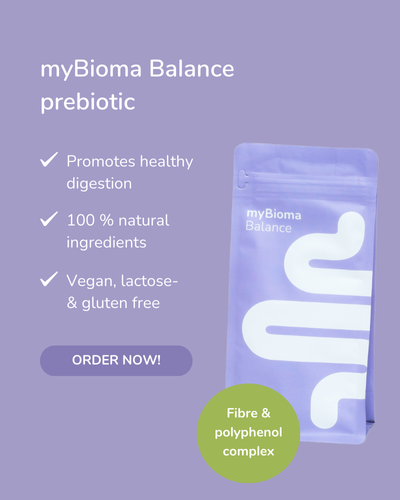Table of contents
- The importance of the gut flora in children
- Interesting facts about the human gut flora in general
- How does the mother's gut flora influence the child's health?
- Aspects affecting the formation of children's gut flora
- Is it possible to build up children's gut flora with a healthy diet?
- How to identify a weakened gut flora in children?
- What are the possible consequences of a weakened gut flora in children?
- Is stool analysis suitable for children?
- Summary: Promoting the development of children's gut flora
- Our children's book: The Gut Heroes - On an adventure through the microbiome
The importance of the gut flora in children
A healthy gut flora (= gut microbiome) is important not only for adults, but also for children: When the gut flora in infants and children becomes imbalanced, also known as dysbiosis, it can persist into adulthood and lead to various issues such as asthma, allergies, immune system disorders, obesity, and eczema (1,2).
In contrast, a robust gut flora in children can bolster the immune system, ward off pathogens and viruses, stave off allergies, and promote optimal digestion, as well as support healthy development and growth. Children's gut flora can naturally develop without the necessity of a "colon cleanse". This article delves into the impact of maternal health and the child's environment, and offers insights on how to positively influence and nurture your child's gut flora.
Interesting facts about the human gut flora in general
Our body is home to over 100 trillion microorganisms (mainly bacteria) that live in symbiosis with our body and perform different tasks. The collection of these microorganisms is referred to as the microbiome. Our primary focus lies in the gut microbiome. A healthy gut flora is characterized by a rich diversity, indicating a wide array of bacterial species. Conversely, a gut flora with low diversity is deemed unhealthy or dysbiotic (3,4).
The gut flora serves numerous vital functions in the body and impacts both physical and mental well-being. Among its crucial roles are preserving the intestinal lining, extracting minerals and vitamins from food and shielding against pathogens like viruses. Moreover, certain gut bacteria possess the ability to metabolize indigestible carbohydrates and fiber into short-chain fatty acids (SCFAs). These SCFAs promote cell growth and maturation, aid in nutrient absorption, regulate hormone production, and play a key role in immune function (4,5).
The gut flora also plays a role in regulating human energy expenditure. The microbiome can extract energy from otherwise indigestible components and can stimulate intestinal movements, resulting in increased energy consumption. Additionally, the absorption of certain vitamins (such as vitamin K, biotin, folic acid, vitamin B12, and pantothenic acid) relies heavily on the gut flora. Furthermore, research is currently underway to understand the connection between the gut flora and the brain. Studies have shown that the gut flora produces hundreds of neurochemical substances that are utilized by the brain to regulate various physiological processes and cognitive functions (6).
Would you like to learn more about the health of your gut flora? Then read our blog post: What is healthy intestinal flora anyway?
How does the mother's gut flora influence the child's health?
The lifestyle of the mother greatly impacts the development of children's gut bacteria. Even before birth, a fetus's gut flora is shaped by the environment in the womb. An unhealthy lifestyle, including smoking, poor diet, sedentary habits, high stress, and antibiotic use, can disrupt the mother's microbiome, affecting the child's development. Additionally, the composition of breast milk is influenced by the mother's lifestyle, making a healthy lifestyle beneficial for the infant during breastfeeding (7).
How to nurture your child's gut flora during pregnancy and breastfeeding (7):
- Maintain a balanced, diverse diet
- Quit smoking
- Use antibiotics only when absolutely necessary
- Minimize stress
- Maintain a healthy sleep schedule
- Include probiotic and prebiotic foods in your diet
- Breastfeed exclusively for at least six months after birth
Which foods are suitable for directly building up the gut flora?
Certain foods are beneficial for fostering a healthy gut flora, notably probiotic and prebiotic foods. Probiotic foods contain live bacteria that colonize the intestines and enhance gut health. Examples of probiotic-rich foods include yogurt, kefir, sauerkraut, kimchi, and other unpasteurized fermented foods (8). Prebiotic foods, on the other hand, contain indigestible components that enhance the growth of beneficial bacteria. These include fiber sources like inulin, oligofructose, and fructooligosaccharides, commonly found in various plant-based foods (9).
Both, the types and variety of foods on our plate impact our microbiome. Consuming a diverse range of foods is recommended to foster a rich array of gut bacteria. For insights into a gut-friendly diet, check out our blog post: Gut-friendly diet - what is it anyway? However, it's essential to recognize that factors beyond diet also influence the gut microbiome positively, including: (7,10):
- Regular physical activity
- Abstaining from nicotine and alcohol
- Maintaining a healthy sleep schedule
- Managing stress levels
- Using antibiotics sparingly and only when necessary, under medical guidance
- Avoiding obesity
For detailed tips on enhancing your diet for a healthier gut, delve into our blog post: the microbiome diet.
Aspects affecting the formation of children's gut flora
Scientists aren't entirely sure if the development of the gut microbiome starts in the womb or post-birth. Yet, recent research leans toward the latter (11). Factors like birth method, environment, breastfeeding, and many others shape how the microbiome forms (12,13). For deeper insights, check out this blog: Mother-child microbiome: Do we inherit our mothers gut flora?
How the gut flora develops after birth:
Breastfeeding is an important factor: breast milk contains important fatty acids, hormones, prebiotics and probiotics, as well as human milk oligosaccharides, which support the development of a healthy intestinal flora in babies. Studies have found that babies who were fed breast milk instead of formula milk had significantly fewer pathogenic germs such as E. coli, Clostridium difficile, bacteria and pathogenic lactobacilli in their intestines. Breastfed babies harbor more helpful bacteria like bifidobacteria, lactobacilli, Collinsella, Megasphaera, and Veillonella compared to non-breastfed infants. Thus, experts suggest breastfeeding for at least six months to support infant gut health (2,14).
Other factors that influence the development of the gut flora of children are (2,14):
-
Pet Ownership: Early exposure to cats and dogs may lower allergy risks. This protective effect is believed to be linked to the animals' microbiome, which children come into contact with.
-
Antibiotic use: Like adults, antibiotics pose challenges for children as they kill both harmful and beneficial gut bacteria, resulting in an adverse shift in the gut flora.
- The environment in which the child grows up: The family's lifestyle, family size, siblings and place of residence (rural or urban) also influence the composition of the gut flora. Additionally, environmental hygiene affects the development of children's gut flora.

Depending on age, various factors influence the development of the child’s gut flora.
Is it possible to build up children's gut flora with a healthy diet?
Encouraging a balanced diet rich in probiotic and prebiotic foods can bolster and nurture children's gut microbiome. Symptoms like constipation, diarrhea, colic and frequent stomachaches in children may indicate an imbalance in gut flora, calling for dietary adjustments. As a parent, you can consider the following steps (8):
- Ensure an adequate fiber intake: Include fiber-rich foods like fruits, vegetables, whole grains, legumes, nuts, and seeds in your child's diet
- Incorporate fermented foods: Introduce fermented foods such as yogurt, kefir, and raw sauerkraut to support gut health
- Limit artificially sweetened and sugary foods
- Avoid highly processed foods
The role of probiotics in promoting gut health
Probiotics are living microorganisms that provide health benefits to humans when consumed in sufficient quantities. These can be ingested either through dietary supplements or naturally occurring probiotic foods. Opting for probiotic-rich foods is preferable for children. Here are some examples (8):
- Natural yoghurt: Contains live, probiotic lactic acid bacteria
- Kefir: A fermented milk drink teeming with probiotics, easily prepared at home
- Sauerkraut and kimchi: The vegetables are preserved through fermentation and the process naturally increases the amount of probiotic bacteria
- Sourdough bread: Contains probiotic lactic acid bacteria due to the fermented dough
Tip: When purchasing probiotic foods, prioritize natural and unpasteurized options. Pasteurization involves high-temperature heating, which can eradicate bacterial cultures (3,8).
How to identify a weakened gut flora in children?
The following symptoms can indicate an imbalanced gut microbiome (15,16):
- Colic in babies: A connection is currently suspected, but this has not yet been fully proven
- Digestive problems: Abdominal pain, flatulence, diarrhea, hard stools or constipation can indicate a disturbed gut flora
- Food intolerances: Sensitive reactions to certain foods such as gluten can indicate a weakened gut flora
- Immune deficiency: Frequent illnesses may suggest a compromised immune system, possibly linked to the gut flora
- Skin Problems: Skin blemishes could indicate dysbiosis in the gut microbiome
What are the possible consequences of a weakened gut flora in children?
If a child's gut microbiome remains weakened over time, dysbiosis can persist into adulthood. An imbalanced gut flora is notably marked by reduced diversity, with harmful bacteria outnumbering beneficial ones. Several conditions are presently linked to early-onset gut flora imbalances. These include (1,15,16,17,18):
- A weakened immune system and resulting autoimmune diseases such as celiac disease, type 1 diabetes and inflammatory bowel disease
- Leaky Gut Syndrome
- Mental illnesses, particularly autism spectrum disorders
- Food intolerances such as gluten sensitivity
- The development of allergies
- Bronchial asthma
- The development of obesity and overweight
- Growth disorders and vitamin deficiency
A weakened gut microbiome in childhood is believed to have numerous other effects. For instance, there's a suspected link to conditions like depression, anxiety disorders, and other mental illnesses. This association stems from the gut-brain axis, through which the gut microbiota communicates with the brain via chemical substances. In summary, the importance of maintaining a healthy gut microbiome in children should not be overlooked (3).
Is stool analysis suitable for children?
At myBioma, we emphasize providing scientifically sound results and recommendations exclusively. Research on the microbiome in children is still in its early stages, with limited availability and consistency of reference values. Children's microbiomes change too rapidly to yield meaningful analysis results. Therefore, we suggest undergoing our microbiome test only after puberty. If you're considering testing your child's intestinal microbiome, we recommend consulting a doctor first.
If symptoms arise, reach out to a specialist.
Allergies, food intolerances, a weakened immune system, recurring gastrointestinal infections and many of the other diseases and symptoms mentioned above are very complex and require medical attention, especially at a young age. While building up the gut flora is a beneficial preventive measure, it's seldom adequate as the sole treatment method. Therefore, if your child displays symptoms, seeking medical advice is crucial to identify any potential underlying causes and to ensure appropriate treatment.
Summary: Promoting the development of children's gut flora
Strengthening children's intestinal flora is a potent preventive measure against numerous diseases in adulthood. Prioritizing a balanced, nutritious diet and lifestyle adjustments over nutritional supplements is advisable, as they can have a significant impact. However, interventions like intestinal treatments, cleansing, or specific diets should be approached cautiously, particularly in children, as they may adversely affect the microbiome. Nonetheless, actively building up the gut flora may be beneficial in certain circumstances, such as after a gastrointestinal infection. Here, you can learn about the best ways to support gut flora recovery following such an infection.
In summary, the following tips emerge:
- Infants: Breastfeed for at least six months, avoiding formula milk if possible
- Toddlers: Avoid excessive hygiene, prepare meals yourself, avoid industrially processed foods, sugar and sweeteners, always have fruit and vegetables available to snack on
- Children from 3 years: Avoid foods that are excessively high in sugar and fat, as well as highly processed foods, offer probiotic and prebiotic foods, and ensure enough movement and sleep
By ensuring a healthy, diverse diet and encouraging outdoor play, interaction with pets, and regular exercise, you're establishing the groundwork for a robust gut microbiome and a resilient immune system in children.
Our children's book: The Gut Heroes - On an adventure through the microbiome
Because we deeply care about the youngest members of our society, we've crafted an engaging children's book with charming illustrations, available in our online store. This captivating picture story introduces children to the workings of digestion in a playful manner, whisking them away into the adventorous world of gut bacteria, guided by the Gut Heroes: Biffi Bifidobacterium, Candi Candida, and Mica Microvirus. Following the journey, children are encouraged to unleash their creativity: interactive pages invite them to write and draw, fostering a fun and educational exploration of how to maintain a healthy and happy gut.
Only available in german.

References
- Fritzsching B. Does a baby’s intestinal flora influence his asthma risk? Pneumo News. 2018;10(3):15–6.
- Munyaka PM, Khafipour E, Ghia JE. External influence of early childhood establishment of gut microbiota and subsequent health implications. Front Pediatr 2014 Oct 9;2.
- Romano K, Shah AN, Schumacher A, Zasowski C, Zhang T, Bradley-Ridout G, et al. The gut microbiome in children with mood, anxiety, and neurodevelopmental disorders: An umbrella review. Good Microb. 2023;4:e18.
- Thursby E, Juge N. Introduction to the human gut microbiota. Biochemical Journal. 2017;474(11):1823–36.
- Saeed NK, Al-Beltagi M, Bediwy AS, El-Sawaf Y, Toema O. Gut microbiota in various childhood disorders: Implication and indications. WJG. 2022;28(18):1875–901.
- Carabotti M, Scirocco A, Maselli MA, Severi C. The gut-brain axis: interactions between enteric microbiota, central and enteric nervous systems. Ann Gastroenterol. 2015;28(2):203–9.
- Radke M. What does breast milk do to the microbiome? Pediatrics. 2019 Feb;31(1):53–53.
- Wang X, Zhang P, Zhang X. Probiotics Regulate Gut Microbiota: An Effective Method to Improve Immunity. Molecules. 2021 Oct 8;26(19):6076.
- Stephen AM, Champ MMJ, Cloran SJ, Fleith M, Van Lieshout L, Mejborn H, et al. Dietary fibre in Europe: current state of knowledge on definitions, sources, recommendations, intakes and relationships to health. Nutr Res Rev. 2017;30(2):149–90.
- Martinez JE, Kahana DD, Ghuman S, Wilson HP, Wilson J, Kim SCJ, et al. Unhealthy Lifestyle and Gut Dysbiosis: A Better Understanding of the Effects of Poor Diet and Nicotine on the Intestinal Microbiome. Front Endocrinol. 2021;12:667066.
- Kennedy KM, de Goffau MC, Perez-Muñoz ME, et al. Questioning the fetal microbiome illustrates pitfalls of low-biomass microbial studies. Nature. 2023;613(7945):639–49.
- Bhattacharyya C, Barman D, Tripathi D, et al. Influence of Maternal Breast Milk and Vaginal Microbiome on Neonatal Gut Microbiome: a Longitudinal Study during the First Year. Microbiol Spectr. 2023;11(3):e04967-22.
- Akagawa S, Akagawa Y, Yamanouchi S, Kimata T, Tsuji S, Kaneko K. Development of the gut microbiota and dysbiosis in children. Bioscience of Microbiota, Food and Health. 2021;40(1):12–8.
- Kim H, Sitarik AR, Woodcroft K, Johnson CC, Zoratti E. Birth Mode, Breastfeeding, Pet Exposure, and Antibiotic Use: Associations With the Gut Microbiome and Sensitization in Children. Curr Allergy Asthma Rep. 2019;19(4):22.
- Bengmark S. Gut microbiota, immune development and function. Pharmacological Research. 2013;69(1):87–113.
- Claßen M. Three-month colic – is the intestinal flora to blame? Pediatrics. 2014;26(4):234–5.
- Taniya MA, Chung HJ, Al Mamun A, Alam S, Aziz MdA, Emon NU, et al. Role of Gut Microbiome in Autism Spectrum Disorder and Its Therapeutic Regulation. Front Cell Infect Microbiol. 2022;12:915701.
- Pantazi AC, Mihai CM, Balasa AL, Chisnoiu T, Lupu A, Frecus CE, et al. Relationship between gut microbiota and allergies in children: a literature review. Nutrients. 2023;15(11):2529.







